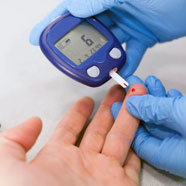
The main NCDs are largely preventable through effective interventions tackling shared modifiable behavioural risk factors. Cardiovascular diseases (like heart attacks and stroke), cancers, chronic respiratory diseases (such as chronic obstructed pulmonary disease and asthma) and diabetes are the leading cause of premature deaths in countries of the Eastern Mediterranean Region, responsible for 66% of all deaths. Two thirds of these premature deaths are linked to the shared modifiable behavioural risk factors: tobacco use, unhealthy diets, physical inactivity and harmful use of alcohol. These unhealthy behaviours lead to key metabolic/biological changes that increase the risk of NCDs: raised blood pressure, overweight/obesity, high blood glucose levels/diabetes, and hyperlipidemia (high levels of fat in the blood).
Risk factors for NCDs often begin early in life and continue through adulthood. However, evidence shows that both prevention and treatment interventions are necessary for reversing the NCD epidemic. Also important for reversing the NCD epidemic is the reduction of indoor and outdoor air pollution. Recent data show that high levels of air pollution are fueling the NCD epidemic. Consequently, it is now an additional risk factor that is being addressed in the action against NCDs. Outdoor and indoor air pollution is causing premature deaths and diseases from stroke, ischemic heart disease, lung cancer and chronic obstructive pulmonary disease.
Burden of risk factors
The Eastern Mediterranean Region has some of the highest rates of tobacco use, overweight and obesity, and physical inactivity of any world region: 90 million adults in the Region are tobacco users; 185 million adults are overweight or obese; and about 130 million adults are physically inactive.
People at risk
Children, adults and the elderly are all vulnerable to the risk factors contributing to NCDs, whether from unhealthy diets, physical inactivity, exposure to tobacco smoke, the harmful use of alcohol or air pollution. These diseases are driven by forces that include rapid unplanned urbanization, globalization of unhealthy lifestyles and population ageing. Unhealthy diets and a lack of physical activity may show up in people as raised blood pressure, increased blood glucose, elevated blood lipids and obesity. These are called metabolic risk factors and can lead to cardiovascular disease, the leading NCD in terms of premature deaths.
Prevention and reduction of risk factors
Reducing the major risk factors for NCDs – tobacco use, physical inactivity, unhealthy diets, the harmful use of alcohol and air pollution – is the focus of WHO’s work to prevent deaths from NCDs. If we reduce the impact of risk factors, we can go a long way to reducing the number of deaths regionally. Prevention of NCDs is a growing issue. Tackling the risk factors will therefore not only save lives, it will also provide a huge boost for the economic development of countries.
WHO response
Among other things, the regional framework for action on the prevention and control of NCDs focuses on strategic interventions for tackling the risk factors that are linked to the main, preventable NCDs. In the area of prevention and reduction of risk factors, the framework supports countries to: accelerate implementation of legal interventions to curb the tobacco epidemic; ensure healthy nutrition, including promoting breastfeeding, regulating the marketing of foods and non-alcoholic beverages to children, reducing salt intake, virtually eliminating trans fat intake and reducing intake of saturated fatty acids; promote physical activity; implement the best buys to reduce the harmful use of alcohol; and implement WHO guidelines and recommended interventions to reduce exposure to air pollution.
The regional framework for action on the prevention and control of NCDs is the road map for countries to implement the UN Political Declaration on NCDs and serves as the regional adaptation of the Global action plan on the prevention and control of NCDs 2013–2020 (extended to 2030). It consists of 19 strategic interventions for countries to implement in the four key areas of: governance; prevention and reduction of risk factors; surveillance, monitoring and evaluation; and health care. It also includes 14 indicators which WHO uses to track and report on progress made by countries. The framework for action on NCDs is the way forward for countries to better prevent, treat and manage NCDs, and improve health and well-being. For most strategic interventions identified in the framework, WHO has developed evidence-based tools to further support countries in taking action against NCDs. Countries need to step up implementation of the regional framework for action, otherwise the health targets of the Sustainable Development Goals will not be met by 2030, including a one third reduction in premature deaths from NCDs (target 3.4).
Read more about the main NCDs
Read more about the risk factors for NCDs
Related links
Global action plan for the prevention and control of NCDs 2013–2020 (extended to 2030)
Regional framework for action (updated October 2019)
UN Political declaration on the prevention and control of NCDs
Voluntary global targets: global monitoring framework for NCDs














